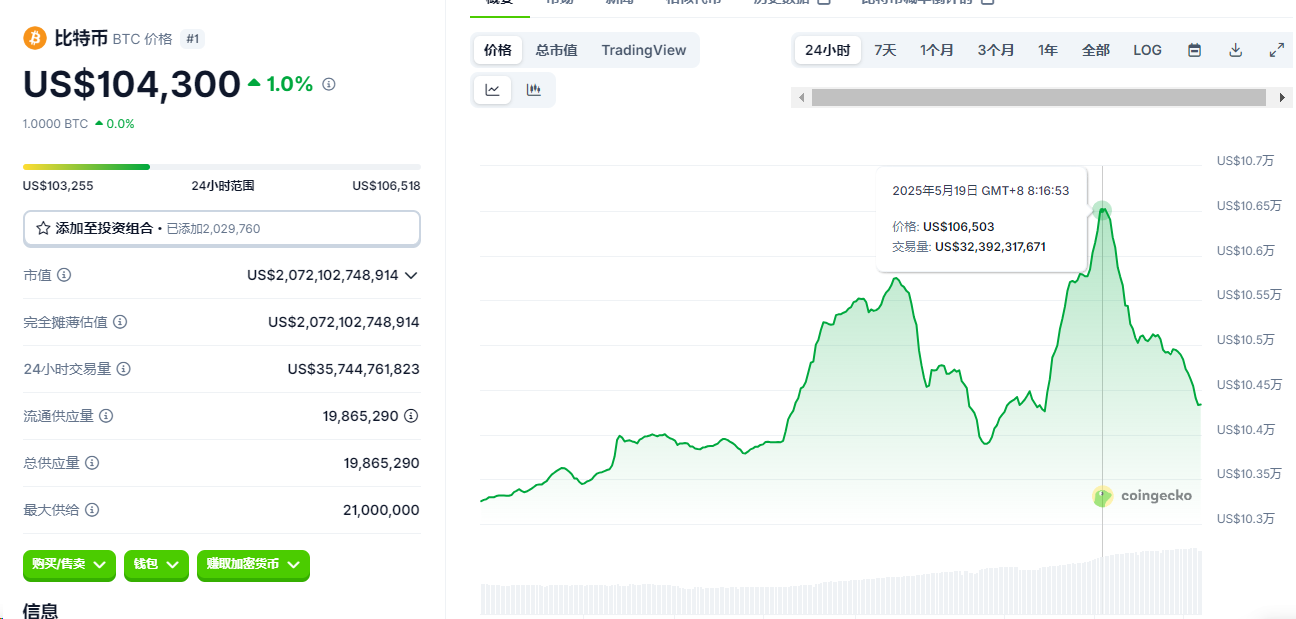On May 19, 2025, the price of Bit broke through $107,000, reaching a historic high. This milestone was not accidental, but driven by a tsunami of institutional funds, macroeconomic policy shifts, and geopolitical economic games. The current price trend shows characteristics distinctly different from past bull markets: retail speculation has receded, with ETF funds, sovereign funds, and corporate balance sheets becoming the market's dominant forces; the Federal Reserve's monetary policy and trade tariff policies have interwoven, reshaping the dual narrative of Bit as an "inflation hedge" and "digital gold"; while the legislative process of the U.S. GENIUS Act may completely rewrite the stablecoin market landscape, thereby influencing Bit's long-term value logic.
ETF Fund Torrent: Institutional Wave Reshaping Market Structure
Continuous fund inflows into U.S. spot Bit ETFs have become the core engine of this rise. According to SoSoValue data, in the first half of May 2025, ETF net inflows exceeded $2.8 billion, with a single-day inflow of $674.9 million on May 2.
As of May 16, the cumulative inflow has reached $41.77 billion, with total managed assets surpassing $122 billion. BlackRock's iShares Bit Trust and Fidelity's Bit fund dominate, together accounting for over 60%. This phenomenon marks an accelerated "institutionalization" of Bit: 80 listed companies hold BTC representing 3.4% of total circulation, and New Hampshire has even legislated to include Bit in state strategic reserves, creating a precedent for sovereign entities allocating crypto assets.
The ETF's fund suction effect has profoundly changed market supply and demand structure. On-chain data shows Bit exchange reserves have dropped to their lowest level since 2018, with over 70% of circulation locked by long-term holders. This "chip sedimentation" phenomenon significantly reduces market volatility, bringing Bit's volatility down from 90% in 2024 to the current 45%, close to the S&P 500 index level. Additionally, Coinbase's inclusion in the S&P 500 on May 19 is expected to trigger around $12 billion in passive fund reallocation, further strengthening Bit's linkage with traditional financial markets.
Macro Game: Stagflation Shadow and Tariff Risk Hedging Demand
Uncertainty in Federal Reserve monetary and trade policies provides a unique macro hedging scenario for Bit. Although the Fed maintains benchmark rates between 4.25%-4.50%, Powell's latest statement hints that the central bank faces the dual challenge of "fighting inflation" and "preventing recession". U.S. April CPI rose 3.8% year-on-year, with core PCE price index at 3.2%, and retail giants like Walmart raising product prices due to tariff costs, intensifying market concerns about "stagflation". In this environment, Bit's "anti-inflation narrative" is reactivated: its fixed supply of 21 million coins starkly contrasts with the Fed's balance sheet expansion—2025 global M2 money supply growth is 8.7% year-on-year, while Bit market value growth reaches 140%.
Trade policy's chain reaction further amplifies Bit's hedging attributes. The 90-day temporary tariff reduction agreement between China and the U.S. failed to ease friction in key industries like electric vehicles and semiconductors, with U.S. average tariffs on Chinese imports still at 19.3%. Walmart's CFO warns that tariff-affected goods' price increases are "unprecedented", potentially pushing core inflation up 0.5-0.8 percentage points. In this context, Bit and gold's 30-day correlation has risen to 0.62, a new high since 2021, indicating its integration into a broader hedging asset portfolio.
Regulatory Tipping Point: GENIUS Act Negotiation and Stablecoin Transformation
The U.S. Senate's final vote on the GENIUS Act becomes a key variable affecting market expectations. The act aims to establish a federal regulatory framework for payment stablecoins, requiring 100% backing by USD or U.S. Treasuries and mandatory audits for projects exceeding $50 billion in market value. Although the May 8 vote failed 48:49, Republican Senator Hagerty and Democratic Senator Gillibrand are pushing a revised bill, seeking balance between "consumer protection" and "innovation incentives".
If passed, the act could trigger three market effects:
- U.S. Dollar Hegemony Strengthening: Requiring 86% of stablecoin reserve assets to be short-term U.S. Treasuries will transform the crypto market into a "new buyer" of U.S. bonds. Currently, Tether already holds $120 billion in U.S. bonds, with a daily average increase of $300 million, forming a "1 USD → 1 USDT + 1 U.S. Treasury" credit expansion chain.
- Institutional Fund Entry Acceleration: Goldman Sachs calculates that the act's implementation will attract at least $12 billion in institutional funds into compliant stablecoins, indirectly boosting Bit demand through cross-market arbitrage.
- Decentralized Asset Value Reassessment: The act's integration of stablecoins into traditional financial regulation will highlight Bit's "non-sovereign attributes". Historical data shows that during regulatory tightening, Bit's on-chain active address count increases by an average of 23%, indicating some funds moving from stablecoins to decentralized assets.
Geopolitical Financialization: National Strategies and Family Capital's Covert Contest
Behind Bit's surge lies a deeper geopolitical game. Developing countries are incorporating Bit into sovereign strategies: high-inflation countries like Turkey and Nigeria have USDT payment proportions exceeding 33%; Iran and Russia use surplus energy for Bit mining, treating it as a foreign exchange alternative channel. The Saudi sovereign wealth fund was recently reported to hold about 25,000 BTC, marking accelerated fusion between the petrodollar system and crypto assets.
Notably, the Trump family's crypto layout becomes a market-sensitive variable. His personal token TRUMP's market value once exceeded $85 billion, and his son Eric's DeFi platform manages over $20 billion in assets. Trump's planned TRUMP dinner poster release on May 22 is interpreted as an attempt to bundle crypto capital with political donations—crypto industry contributions to the 2024 election already exceed $200 million. This "politics + finance" operational strategy both injects short-term liquidity into Bit and plants risks of policy reversals.
Risk Warning: High Leverage Bubble and Maturity Mismatch Crisis
Behind market euphoria, potential risks are accumulating. Derivatives market leverage reaches a historic high: network-wide mortgage lending scale has surged 240% in three months, with Bit futures open interest reaching $48 billion, 65% being high-leverage positions. When Trump announced Bit reserve establishment in March 2025, a single-day 5% drop led to $710 million in liquidations, signaling potential normalization of extreme volatility.
A more severe risk lies in the stablecoin system's maturity mismatch. Tether holds 86% of U.S. bonds as short-term debt within one year, while 41% of issued USDT is long-term locked. This "short debt, long investment" model closely resembles the 2008 subprime crisis CDO bubble, and a potential bank run could trigger a chain reaction of U.S. bond sell-offs and USD credit collapse.
Future Outlook: Collision of Technological Revolution and Old Order
Bit breaking $100,000 marks a "fission moment" in global monetary order. From a technological perspective, Lightning Network transaction speed has increased to 100,000 TPS, DeFi locked volume has exceeded $500 billion, making its payment and financial functions increasingly sophisticated; from a geopolitical perspective, Hong Kong has approved licenses for 8 digital asset exchanges and plans to launch Bit futures and options, attempting to compete for pricing rights in the Web3 era.
However, the essence of this transformation is still the collision between technology-enabled financial revolution and the dilemma of US dollar hegemony. Bitcoin both relies on the US dollar system (73% of stablecoins are anchored to the US dollar) and is hollowing out its foundation (monetary debt relies on the crypto market to take over). This self-negating paradox makes it the "ultimate gambling tool" of global capital - both an escape pod for the old order and a risk testing ground for the new world.
For investors, they need to be wary of the double harvest of policy arbitrage and market manipulation; for sovereign countries, this game may reshape the boundaries of monetary sovereignty and financial stability. When the price scale of Bitcoin changes from a "dollar sign" to a "power weight", what we are witnessing is not just the rise and fall of assets, but the turning point of an era.







